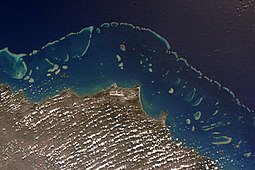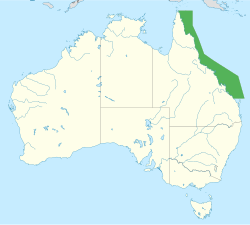This article may be in need of reorganization to comply with Wikipedia's layout guidelines. (July 2024) |
| UNESCO World Heritage Site | |
|---|---|
 Image of part of the Great Barrier Reef adjacent to Queensland, taken from the International Space Station | |
| Location | Off the east coast of the Queensland mainland, Australia |
| Criteria | Natural: vii, viii, ix, x |
| Reference | 154 |
| Inscription | 1981 (5th Session) |
| Area | 34,870,000 ha (86,200,000 acres) |
| Website | www |
| Coordinates | 16°24′S 145°48′E / 16.400°S 145.800°E |
 Locator map of the protected area | |
The Great Barrier Reef is the world's largest coral reef system,[1][2] composed of over 2,900 individual reefs[3] and 900 islands stretching for over 2,300 kilometres (1,400 mi) over an area of approximately 344,400 square kilometres (133,000 sq mi).[4][5] The reef is located in the Coral Sea, off the coast of Queensland, Australia, separated from the coast by a channel 160 kilometres (100 mi) wide in places and over 61 metres (200 ft) deep.[6] The Great Barrier Reef can be seen from outer space and is the world's biggest single structure made by living organisms.[7] This reef structure is composed of and built by billions of tiny organisms, known as coral polyps.[8] It supports a wide diversity of life and was selected as a World Heritage Site in 1981.[1][2] CNN labelled it one of the Seven Natural Wonders of the World in 1997.[9] Australian World Heritage places included it in its list in 2007.[10] The Queensland National Trust named it a state icon of Queensland in 2006.[11]
A large part of the reef is protected by the Great Barrier Reef Marine Park, which helps to limit the impact of human use, such as fishing and tourism. Other environmental pressures on the reef and its ecosystem include runoff of humanmade pollutants, climate change accompanied by mass coral bleaching, dumping of dredging sludge and cyclic population outbreaks of the crown-of-thorns starfish.[12] According to a study published in October 2012 by the Proceedings of the National Academy of Sciences, the reef has lost more than half its coral cover since 1985, a finding reaffirmed by a 2020 study which found over half of the reef's coral cover to have been lost between 1995 and 2017, with the effects of a widespread 2020 bleaching event not yet quantified.[13][14]
The Great Barrier Reef has long been known to and used by the Aboriginal Australian and Torres Strait Islander peoples, and is an important part of local groups' cultures and spirituality. The reef is a very popular destination for tourists, especially in the Whitsunday Islands and Cairns regions. Tourism is an important economic activity for the region, generating over AUD$3 billion per year.[15] In November 2014, Google launched Google Underwater Street View in 3D of the Great Barrier Reef.[16]
A March 2016 report stated that coral bleaching was more widespread than previously thought, seriously affecting the northern parts of the reef as a result of warming ocean temperatures.[17] In October 2016, Outside published an obituary for the reef;[18] the article was criticised for being premature and hindering efforts to bolster the resilience of the reef.[19] In March 2017, the journal Nature published a paper showing that huge sections of an 800-kilometre (500 mi) stretch in the northern part of the reef had died in the course of 2016 of high water temperatures, an event that the authors put down to the effects of global climate change.[20] The percentage of baby corals being born on the Great Barrier Reef dropped drastically in 2018 and scientists are describing it as the early stage of a "huge natural selection event unfolding". Many of the mature breeding adults died in the bleaching events of 2016–17, leading to low coral birth rates. The types of corals that reproduced also changed, leading to a "long-term reorganisation of the reef ecosystem if the trend continues."[21]
The Great Barrier Reef Marine Park Act 1975 (section 54) stipulates an Outlook Report on the Reef's health, pressures, and future every five years. The last report was published in 2019.[22] In March 2022, another mass bleaching event has been confirmed, which raised further concerns about the future of this reef system, especially when considering the possible effects of El Niño weather phenomenon.[23]
The Australian Institute of Marine Science conducts annual surveys of the Great Barrier Reef's status, and the 2022 report showed the greatest recovery in 36 years. It is mainly due to the regrowth of two-thirds of the reef by the fast-growing Acropora coral, which is the dominant coral there.[24]
- ^ a b UNEP World Conservation Monitoring Centre (1980). "Protected Areas and World Heritage – Great Barrier Reef World Heritage Area". Department of the Environment and Heritage. Archived from the original on 11 May 2008. Retrieved 14 March 2009.
- ^ a b "The Great Barrier Reef World Heritage Values". Archived from the original on 9 May 2013. Retrieved 3 September 2008.
- ^ The Great Barrier Reef World Heritage Area, which is 348,000 km squared, has 2900 reefs. However, this does not include the reefs found in the Torres Strait, which has an estimated area of 37,000 km squared and with a possible 750 reefs and shoals. Hopley, Smithers & Parnell 2007, p. 1
- ^ Fodor's. "Great Barrier Reef Travel Guide". Archived from the original on 14 May 2013. Retrieved 8 August 2006.
- ^ Department of the Environment and Heritage. "Review of the Great Barrier Reef Marine Park Act 1975". Archived from the original on 18 October 2006. Retrieved 2 November 2006.
- ^ Leong, Goh Cheng (1995). Certificate Physics And Human Geography; Indian Edition. Oxford University Press. p. 81. ISBN 978-0-19-562816-6. Archived from the original on 20 June 2022. Retrieved 21 January 2022.
- ^ Sarah Belfield (8 February 2002). "Great Barrier Reef: no buried treasure". Geoscience Australia (Australian Government). Archived from the original on 1 October 2007. Retrieved 11 June 2007.
- ^ Sharon Guynup (4 September 2000). "Australia's Great Barrier Reef". Science World. Archived from the original on 8 July 2012. Retrieved 11 June 2007.
- ^ "The Seven Natural Wonders of the World". CNN. 1997. Archived from the original on 21 July 2006. Retrieved 6 August 2006.
- ^ "National Heritage List: The Great Barrier Reef, Queensland". Department of Agriculture, Water and the Environment. Archived from the original on 22 April 2021. Retrieved 23 April 2021.
- ^ National Trust Queensland. "Queensland Icons". Archived from the original on 10 December 2006. Retrieved 27 April 2021.
- ^ Smee, Ben (20 February 2019). "Great Barrier Reef authority gives green light to dump dredging sludge". The Guardian. ISSN 0261-3077. Archived from the original on 21 February 2019. Retrieved 21 February 2019.
- ^ Eilperin, Juliet (1 October 2012). "Great Barrier Reef has lost half its corals since 1985, new study says". The Washington Post. Archived from the original on 9 February 2019. Retrieved 1 October 2012.
- ^ Amy Woodyatt (13 October 2020). "The Great Barrier Reef has lost half its corals within 3 decades". CNN. Archived from the original on 15 October 2020. Retrieved 17 October 2020.
- ^ Cite error: The named reference
economicswas invoked but never defined (see the help page). - ^ "Google Launches Underwater Street View". 16 November 2014. Archived from the original on 29 November 2014.
- ^ "Great Barrier Reef coral bleaching more widespread than first thought". The Sydney Morning Herald. 31 March 2016. Archived from the original on 3 April 2016. Retrieved 2 April 2016.
- ^ Jacobsen, Rowan (11 October 2016). "Obituary: Great Barrier Reef (25 Million BC–2016)". Archived from the original on 16 October 2016. Retrieved 16 October 2016.
- ^ Lewis, Sophie. "The Great Barrier Reef is not actually dead". CNN. Archived from the original on 12 March 2017.
- ^ Cave, Damien; Gillis, Justin (15 March 2017). "Large Sections of Australia's Great Reef Are Now Dead, Scientists Find". The New York Times. ISSN 0362-4331. Archived from the original on 20 February 2018. Retrieved 19 February 2018.
- ^ "Great Barrier Reef coral bleaching causes numbers of baby coral to plummet". Australian Broadcasting Corporation. 4 April 2019. Archived from the original on 10 April 2019.
- ^ "Great Barrier Reef Outlook Report 2019". Great Barrier Reef Marine Park Authority. Archived from the original on 1 September 2019. Retrieved 3 November 2019.
- ^ "Great Barrier Reef: Australia confirms new mass bleaching event". BBC News. 25 March 2022. Archived from the original on 25 March 2022. Retrieved 25 March 2022.
- ^ "Annual Summary Report of Coral Reef Condition 2021/22". AIMS. 4 August 2022. Archived from the original on 13 November 2022. Retrieved 2 January 2023.